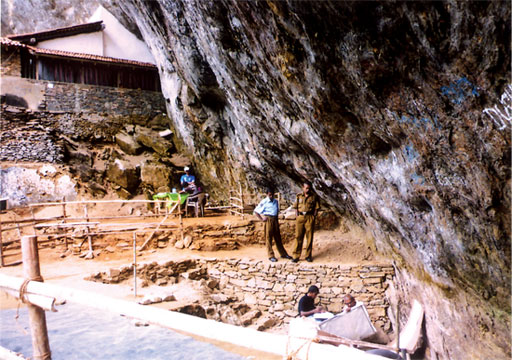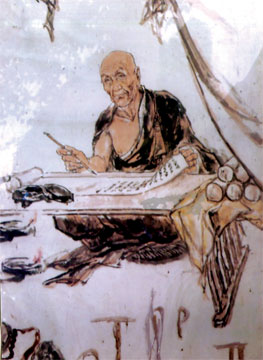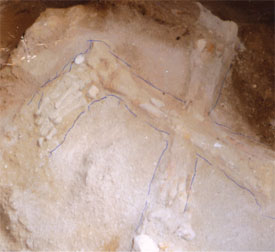|
Pahiyangala rock caves:
Excavations reveal 37,000-year civilisation
by Divakara MOHOTTI, Kalutara Gr. Cor
 |
|
Security is provided to the
excavation site round-the-clock |
The wonderful scenery of the mountain ranges, the peaceful
environment created by the extensive ranges of forests and
multi-coloured foliage and the greenery which surrounds the well-known
Pahiyangala natural mountain captures the eye of any nature observers.
Most rock caves in India and Sri Lanka have historic value, not only
as naturally formed rocks where animals dwelt, but as the residential
quarters of great bhikkhus of fame and piety. They had been populated by
bhikkhus who spent their lives in meditational practice.
The rock caves of India, Sariputta Lena, Mugalan Lena, Kassapa Lena
and Ananda Lena, found on either side of the path leading to the
well-known Gijjhakuta rock, were known as places of residence of the
Buddha and the caves are named under some of His great followers.
In the same manner, on instructions issued by Arahat Mahinda Thera,
who brought the message of the Buddha to Sri Lanka, a number of caves in
the precincts of the Mihintale rock in the Anuradhapura district had
been used by bhikkhus to meditate till they reached the stage of
Arahantship. It is said that 68 such rock caves existed and had been
used by bhikkhus of ancient Sri Lanka.
|

A portrait of Fa-Hsien, who used the Pahiyangala cave |
The huge rock known as Pahiyangala is situated within the Divisional
Secretariat of Bulathsinhala in a village called Yatagampitiya.
The well-known rock cave of Pahiyangala is in the boundary of the
Ratnapura district. Its approach is from Colombo through Kesbewa and
Horana on the road to Kalawellewa, about 40 miles away or 56 miles via
Kalutara.
On reaching the Yatagampitiya village temple, one’s eyes will not
miss the rock which can be climbed through a flight of steps. The
mountain range on which the famous Pahiyangala rock cave is situated is
about 570 acres in extent and about 400 ft above sea level.
The cave is semi-circular. The entrance is about 150 ft high and 175
ft wide. It can safely accommodate about 3,000 people during heavy rain
or natural disasters.
The length of the cave is about 282 ft. The widest spot inside is
about 160 ft in extent. Accordingly, it is about thrice the extent of
the well-known Dambulla Rock Cave.
The importance of the Pahiyangala rock cave is threefold; it is the
largest rock cave in Sri Lanka, it has been the living quarters of the
most ancient human beings of Asia, and it was used by the famous
traveller of Chinese origin, Bhikkhu Fa-Hsien.
Historical evidence
According to historical evidence, the origin of the rock cave can be
traced back to millions of years. Perhaps due to the direction of
monsoon rains, the walls of the rock cave may have remained straight and
undamaged.
|

The skeleton found in the cave |
Due to the collection of rock splinters which still remain, though
removed from the mouth of the cave by attacks of weather, the rock cave
remains safe and has even slightly extended. From 1956-1987, various
surveys and excavations had been conducted there by the Department of
Archaeology.
The excavations and surveys have brought important and interesting
information of highly valuable historical importance. Carbon 14 tests
conducted on some of the artifacts found at this rock cave and
surroundings have revealed important findings of archaeological and
historical value to determine the existence of ancient human
civilisations.
Two of the human skulls and implements used by our ancestors
discovered from the site are reportedly of high value. One of the human
skulls found here has revealed the existence of human beings over 37,000
years ago and belongs to the Metamorphic period of history or the Middle
Ages.
The only other discovery of such ancient value had been found at the
Batadomba Lena which revealed the existence of the Balangoda Manawaya
(Balangoda human species) which is believed to be the most ancient
existence of human beings in Sri Lanka.
This discovery also reveals historic events which are over 28,000
years old. However, the findings of the Pahiyangala rock cave belong to
a period over 37,000 years ago. Thus is the importance of the
Pahiyangala findings to determine the historical importance of Sri Lanka
and its people.
Bones, remains
The finding of implements used by human beings of that era and what
they consumed as food can also be determined from the discoveries.
Some of the bones of animals discovered have been grouped as the
bones of boar, deer, porcupine, forest monkey and armadillo (Kaballawa).
This is evidence that these people consumed such animals.
Among the discoveries were also the remains of tree-snails and water
snails. It has been found that the people also lived on fruits such as
Kele Del (Val del - breadfruit) and Kekuna.
Evidence found in the second layer of soil has also revealed that the
people used food which was burnt.
The Chinese Buddhist traveller Fa-Hsien, who had arrived in Sri Lanka
during the Fifth Century AD, during the reign of King Mahanama of
Anuradhapura, had visited Sri Pada which is near Pahiyangala and also
lived in the Pahiyangala rock cave.
History reveals that most of Sri Lanka’s ancient people used rivers,
waterfalls and streams as a method of transport.
The stream that flows by the Pahiyangala rock cave appears to have
been used as an alternative route to reach Sri Pada.
Villages such as Gavaragiriya, Ayagama and Kuruwita are not far from
the Pahiyangala rock. It is an easy approach to Sri Pada via these
villages. It is said that Fa-Hsien used this road to go to Sri Pada.
Across this mountain is the district of Ratnapura. Towards its west is
the district of Kalutara.
Ancient beliefs
According to ancient beliefs, the two districts have been connected
by a range of rocks. Hence the popular belief that the two districts are
connected together (Pa hima in Sinhalese); this is how the name
Pahiyangala (the rock which made the connection) came to existence.
Later, the name came to be interpreted as the cave where Fa-Hsien had
stayed - Pahiyan (Fa-Hsien) gala. The place was maintained as a Buddhist
place of worship for nearly 400 years.
The practice of bhikkhus staying there was started by Ven. Porowagama
Thera who endured many difficulties including wild animals. After him
Ven. Werawatte Sobhita Thera, Ven. Wewala Dhammajothi Thera, Ven.
Udumulle Saranankara Thera, Ven. Udugalhande Jinanda Thera, Ven.
Jamburaliya Pannananda Thera, Ven. Wewala Dhammaransi Thera and Ven.
Kandana Pannasekara Thera lived and looked after the maintenance of the
temple, the rock cave and its surroundings.
According to the officers of the Archaeological Department, pieces of
charcoal excavated from the premises have been sent for testing to
determine their age.
The human skeleton unearthed during the excavations is the first of
its kind found at such a site.
This skeleton had been in some clay pots which were found on the face
of the first layer of soil. The skeleton remains where it was discovered
and steps are being taken to keep it in position till all excavations
are completed.
|

